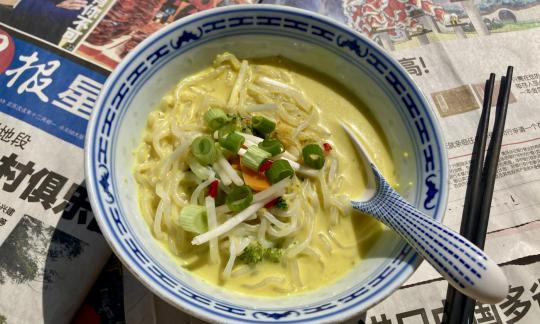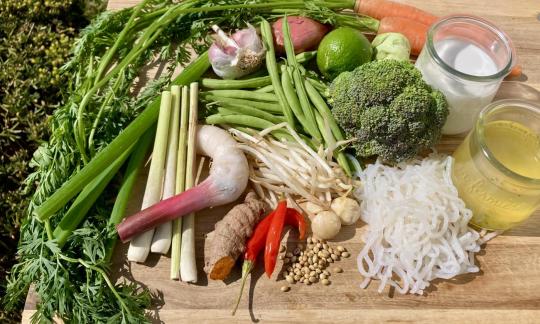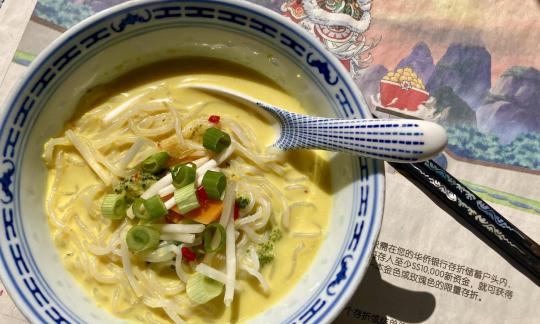Vegan low-calorie Laksa soup with Shirataki noodles
vegan
Ingredients (for servings, )
Equipment
- hand-held blender / immersion blender
- mortar
- stove
- citrus juicer (lemon squeezer)
- saucepan
- sieve
Type of preparation
- cook
- chop or grind
- sweat
- season to taste
- purée
- remove the skin
- peel
- drain
Preparation
Prepare your own coconut milk (optional)
Put the coconut flesh and water into a blender and mix until you have a white, creamy liquid (coconut milk). Set aside for later use.If you have some coconut milk left over, you can either add it to the soup or use it for other dishes.
Alternatively, you can use canned coconut milk (see tips).For the paste
Peel the garlic and shallots and chop roughly. Cut the top third off the lemongrass and remove the hard outer shell and put to one side. Cut the rest into thin slices. Peel the galangal and chop finely. Peel the turmeric and chop roughly (be careful, it stains a lot - see tips). Remove the stalks from the chili. Crush the coriander seeds in a mortar. Put everything in a blender together with the macadamia nuts and use a hand blender to process into a paste.10 g of macadamia nuts is equivalent to about 3 pieces.
Preparation of the soup base
Heat the rapeseed oil in a pan and sauté the paste in it. After about 2-3 minutes, add the drinking water, vegetable stock and the rest of the lemongrass from step 2 and stir. Let the soup simmer for about 15 minutes. Then remove the lemongrass. In the meantime, continue with the next steps.You can also leave out the rapeseed oil, as the liquid will prevent the paste from sticking.
You can also leave the lemongrass in until the end. It can be easily removed when eating.
For the soup garnish
If you are using dried pasta, place it in boiling, lightly salted water and cook for 5 minutes. Then place it in a colander, rinse and drain. If you are using pre-cooked pasta in liquid, place it in a colander and rinse well. The initial fishy smell is normal, but will disappear. Place it in a small saucepan and cook for about 2 minutes. Then drain and set aside.Wash the beans, cut off the ends and halve. Wash the broccoli and divide into small florets. Peel the stalk, halve and cut into thin slices. Clean the carrots, peel if necessary and cut into pieces about 2 cm long. Cut these into thin slices. Add the vegetables to the soup and simmer for about 10-15 minutes.
For the topping, wash the mung bean sprouts and let them drain. Cut off the root ends. Clean the spring onions and cut into rings. Set both aside.Finishing and serving the soup
Add the coconut milk and heat it up. Season the laksa soup with lime juice, date syrup and soy sauce or salt if desired.
Add the shirataki noodles to the soup and heat briefly. Pour the laksa soup into soup bowls and serve with spring onions and sprouts as a topping.
|
Nutritional Information per person
Convert per 100g
|
2000 kcal | |
|---|---|---|
| Energy | 252 kcal | 12.6% |
| Fat/Lipids | 13 g | 18.6% |
| Saturated Fats | 6.1 g | 30.3% |
| Carbohydrates (inc.dietary fiber) | 35 g | 12.8% |
| Sugars | 11 g | 12.6% |
| Fiber | 12 g | 46.3% |
| Protein/Albumin | 6.7 g | 13.4% |
| Cooking Salt (Na:85.0 mg) | 216 mg | 9.0% |
| Essential micronutrients with the highest proportions | per person | 2000 kcal | |
|---|---|---|---|
| Vit | Vitamin K | 118 µg | 158.0% |
| Vit | Vitamin C (ascorbic acid) | 76 mg | 96.0% |
| Min | Manganese, Mn | 1.9 mg | 95.0% |
| Vit | Vitamin A, as RAE | 463 µg | 58.0% |
| Vit | Folate, as the active form of folic acid (née vitamin B9 and | 113 µg | 57.0% |
| Elem | Potassium, K | 843 mg | 42.0% |
| Min | Copper, Cu | 0.38 mg | 38.0% |
| Vit | Vitamin B6 (pyridoxine) | 0.48 mg | 34.0% |
| Min | Iron, Fe | 4.3 mg | 31.0% |
| Prot | Tryptophan (Trp, W) | 0.07 g | 28.0% |
Detailed Nutritional Information per Person for this Recipe
The majority of the nutritional information comes from the USDA (US Department of Agriculture). This means that the information for natural products is often incomplete or only given within broader categories, whereas in most cases products made from these have more complete information displayed.
If we take flaxseed, for example, the important essential amino acid ALA (omega-3) is only included in an overarching category whereas for flaxseed oil ALA is listed specifically. In time, we will be able to change this, but it will require a lot of work. An “i” appears behind ingredients that have been adjusted and an explanation appears when you hover over this symbol.
For Erb Muesli, the original calculations resulted in 48 % of the daily requirement of ALA — but with the correction, we see that the muesli actually covers >100 % of the necessary recommendation for the omega-3 fatty acid ALA. Our goal is to eventually be able to compare the nutritional value of our recipes with those that are used in conventional western lifestyles.
| Essential fatty acids | per person | 2000 kcal |
|---|---|---|
| Alpha-Linolenic acid; ALA; 18:3 omega-3 | 0.35 g | 17.0% |
| Linoleic acid; LA; 18:2 omega-6 | 1.00 g | 10.0% |
| Essential amino acids | per person | 2000 kcal |
|---|---|---|
| Tryptophan (Trp, W) | 0.07 g | 28.0% |
| Threonine (Thr, T) | 0.26 g | 28.0% |
| Isoleucine (Ile, I) | 0.24 g | 19.0% |
| Valine (Val, V) | 0.29 g | 18.0% |
| Lysine (Lys, K) | 0.32 g | 17.0% |
| Phenylalanine (Phe, F) | 0.25 g | 16.0% |
| Leucine (Leu, L) | 0.36 g | 15.0% |
| Methionine (Met, M) | 0.08 g | 8.0% |
| Vitamins | per person | 2000 kcal |
|---|---|---|
| Vitamin K | 118 µg | 158.0% |
| Vitamin C (ascorbic acid) | 76 mg | 96.0% |
| Vitamin A, as RAE | 463 µg | 58.0% |
| Folate, as the active form of folic acid (née vitamin B9 and | 113 µg | 57.0% |
| Vitamin B6 (pyridoxine) | 0.48 mg | 34.0% |
| Thiamine (vitamin B1) | 0.24 mg | 22.0% |
| Riboflavin (vitamin B2) | 0.26 mg | 18.0% |
| Pantothenic acid (vitamin B5) | 1.0 mg | 17.0% |
| Niacin (née vitamin B3) | 2.2 mg | 14.0% |
| Vitamin E, as a-TEs | 1.3 mg | 10.0% |
| Biotin (ex vitamin B7, H) | 3.8 µg | 8.0% |
| Essential macroelements (macronutrients) | per person | 2000 kcal |
|---|---|---|
| Potassium, K | 843 mg | 42.0% |
| Phosphorus, P | 176 mg | 25.0% |
| Magnesium, Mg | 76 mg | 20.0% |
| Calcium, Ca | 134 mg | 17.0% |
| Sodium, Na | 85 mg | 11.0% |
| Essential trace elements (micronutrients) | per person | 2000 kcal |
|---|---|---|
| Manganese, Mn | 1.9 mg | 95.0% |
| Copper, Cu | 0.38 mg | 38.0% |
| Iron, Fe | 4.3 mg | 31.0% |
| Zinc, Zn | 1.5 mg | 15.0% |
| Selenium, Se | 4.4 µg | 8.0% |
| Iod, I (Jod, J) | 12 µg | 8.0% |
| Fluorine, F | 129 µg | 4.0% |
The spicy, vegan Laksa soup with Shirataki noodles is a healthy and low-calorie soup for losing weight. Unfortunately, it has 21 ingredients including coconut, so it has a lot of saturated fats.
Nutrient profile: According to GDA guidelines, one portion of this low-calorie dish covers more than the average daily requirement of vitamin K. Manganese and vitamin C are covered by over 80% and folic acid by around 50%. However, some of the heat-sensitive ingredients are lost during the cooking process, which slightly reduces the amount per portion. The ratio of omega-6 to omega-3 fatty acids is 3:1, which is below the recommended ratio of 5:1.
You can find further information on this topic at the following link: Vegans often eat unhealthily. Avoidable nutritional errors.
Preparation time: Please note that the preparation time does not include the time required to prepare the coconut milk.
Laksa: Laksa is a Southeast Asian soup from Malaysia and Singapore. There are numerous variations such as Penang Laksa (Malaysian) or Katong Laksa (Singaporean), although the basic ingredients and pastes differ. This recipe is based on the Singaporean Laksa.
Shirataki noodles: Shirataki noodles, also known as konjac noodles, are particularly popular in Japanese and Chinese cuisine. Shirataki noodles look similar to glass noodles, but are as thick as spaghetti. Unlike glass noodles, which are usually made from starch from peas, corn or mung beans, Shirataki noodles are made from konjac roots, which is why they contain hardly any usable carbohydrates. They are therefore gluten-free, low in calories and filling. They have little taste of their own and their smell is slightly fishy.
Turmeric: Turmeric, also known as yellow ginger or turmeric root, comes from South Asia and belongs to the ginger family. Curcumin, one of the orange-yellow pigments in turmeric, has many beneficial effects on health, such as anti-cancer and anti-inflammatory properties and antioxidant potential. Fresh turmeric has a resinous, slightly burning taste; when dried, it tastes milder and slightly bitter.
Ginger: The ginger rhizome has an aromatic smell and a sharp, spicy taste, which is due to the substance gingerol, which is said to have anti-carcinogenic and anti-inflammatory effects. The substances borneol and cineole give ginger its digestive, antiemetic, appetite-stimulating and circulatory properties.
Lemongrass: Lemongrass, also known as "lemon grass", has a reed-like appearance and develops its lemony taste best when fresh. Essential oils are responsible for the intense scent.
Coconut milk is not coconut water: Coconut milk is made by pureeing the flesh of a coconut with water and then squeezing it through a cloth. This coconut milk is not to be confused with coconut water. Coconut water appears next to the flesh when a coconut is opened.
Turmeric can stain: If you use fresh turmeric, it is advisable to wear gloves when processing it, as turmeric stains extremely strongly. The root can also permanently stain light-colored kitchen utensils yellow. Alternatively, try to only touch the peeled root with your fingertips and then wash your hands. Oil helps to remove the color from both hands and objects.
Reduce salt and oil: We have deliberately reduced oil and salt for health reasons, the latter by using extra low-salt vegetable broth. You can find more information on this topic in the book we describe in detail: "Salt Sugar Fat" by Michael Moss.
Storing Asian spices: Fresh lemongrass will keep for a few days in the fridge. It can be frozen for up to 6 months. Fresh galangal and chili can also be stored frozen, the former best cut into slices.
Make your own broth / stock: If you want to make your own vegetable broth or stock, you will find suitable recipes below:
- Instant vegetable broth with carrots, celery and leek
- Vegan vegetable stock with celery, leek, fennel
- Organic mushroom vegetable broth with carrots and celery
Classic Asian Laksa: For a classic Asian Laksa, you use candelnuts, also known as light nuts or Indian walnuts, instead of macadamia nuts. The laksa leaves, which are responsible for the characteristic taste, have been omitted in this recipe. In the classic Laksa, the paste is red due to dried shrimps and a large amount of red chili, both fresh and dried.
Fresh turmeric or dried, ground turmeric: If you don't have fresh turmeric root, you can replace it with the ground version. For the corresponding replacement, add about 1 teaspoon of the ground form to about 20 grams of fresh turmeric. However, the dried form has a significantly different taste (see notes).
Vary the filling: You can also use zucchini or peppers or other vegetables instead of broccoli.
Coconut milk: We have deliberately used homemade coconut milk. However, you can also use canned coconut milk. In both cases, make sure to use organic products and those that have not been harvested using monkeys. Products from Sri Lanka and Vietnam are considered cruelty-free, whereas monkeys are often used in products from Thailand. Since, contrary to popular belief, coconut oil is more unhealthy than healthy due to its very high proportion of saturated (medium-chain and long-chain) fatty acids, we rarely use coconut milk. In this case, however, despite coconut milk, the LA:ALA ratio is in a very good range (see above).
Spiciness: This dish is traditionally considered to be rather spicy. If you prefer it milder, remove the seeds from the chili or use less.








